Whale of a task
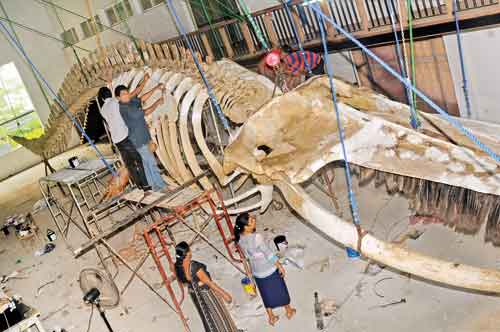
Easy does it: Museum officials oversee the installation of the blue whale skeleton in its new home. Pic courtesy National Museum
Remember visiting the Colombo National Museum as children and being awestruck by the gigantic skeleton of the blue whale? The ‘whale’ synonymous with the Colombo Museum has now shifted to the new Osteology Gallery of the Natural History Museum, which will be open to the public from tomorrow. This new addition to the Natural History Museum, coming under the Colombo National Museum, will also become home to nearly 30 exhibits of mammal, bird and reptile skeletons.
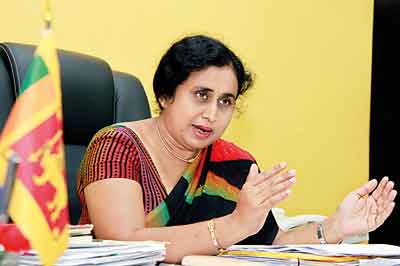
Director, Department of National Museums Sanuja Kasthuriarachchi
Parallel to the opening of the Osteology Gallery, the upgraded Geology and Plant Science Galleries of the Natural History Museum will also be open to the public.
Speaking to the Sunday Times, Director, Department of National Museums, Sanuja Kasthuriarachchi says, that the addition of an Osteology Gallery is a means of benchmarking our museum with internationally renowned museums. “All world renowned museums claim an Osteology Gallery dedicated to skeletons and bony structures of animals and our new gallery is in recognition of this.” The Osteology Gallery fills the long-felt lacuna for a single gallery to which the specimens, previously exhibited at the Natural History Museum will be transferred.
The iconic blue whale of the Colombo National Museum which led a ‘solitary existence’ for a century and more in its East Wing, will now enjoy the company of the Greater flamingo, Sri Lankan monitor, Bridled tern, Green turtle, Ring-tailed civet, Sri Lankan giant squirrel, Long finned Eel and many more in a ‘habitat’ of their own. And guess what? It can engage in ‘mammoth talk’ with none other than Heiyanthuduwa Raja!
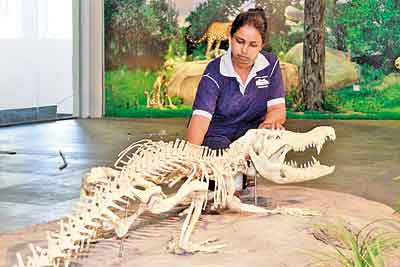
Setting up an exhibit
Shifting the blue whale skeleton of 61 vertebrae and 13 ribs from its former shelter in the East Wing to its new home has indeed been a mammoth task for the museum authorities. The Museum Chief applauds her team of taxidermists for a job well done. “Transporting the blue whale skeleton had to be done with extreme care and our team of conservationists worked tirelessly to assemble and further conserve it which took almost a year as it required minute attention,” notes Ms. Kasthuriarachchi.
Throwing light on the journey of the blue whale’s skeleton to the Colombo Museum, Assistant Director of Zoology, Department of National Museums, Lankani Somarathna says the 65 ft long whale had been washed ashore in Ambalangoda in September 1894. “According to the administrative reports, the skeleton has been installed here in 1910,” she says. As the Administrative Report of 1894 furnished by the Colombo National Museum affirms: ‘In September, a large whale was washed ashore in Ambalangoda. The taxidermist was immediately dispatched to the spot to secure the skeleton. This work was of great difficulty and not without danger; in consequence of the roughness of the sea and the numerous sharks which swarmed around the carcass. It does the taxidermist great credit that he should have secured the skeleton complete.’ The re-installation of the skeleton which weighs several tons had been a laborious task says Ms. Somarathna who credits her team including Dr. Manori Gunathilaka, Assistant Director of Entomology and Taxidermist, Chamalka Kothalawala
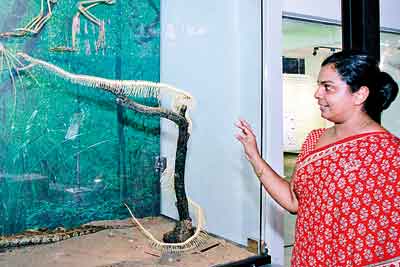
Lankani Somarathna with an exhibit
The skeleton has been further conserved and is now supported by G1 pipes replacing iron bars, explains Ms. Kothalawala. “This
prevents the specimen being exposed to the rust gathered on iron bars,” she notes. Conserving the skin of an animal is a challenging task as Ms. Kothalawala, the first woman taxidermist to serve the Department of National Museums and so far the only woman to hold the position in South East Asia explains. “The preservation process of the skin of a dead animal should begin within 12 hours from the time of its death as the animal skin decays rapidly.” The work becomes even more demanding in case of large creatures such as whales and elephants.
Another highlight of the new Osteology Gallery is the skeleton exhibited of Heiyanthuduwa Raja who had the distinction of carrying the casket bearing the Sacred Tooth Relic at the Kandy Esala Perahera for 11 years. Raja’s 2.3 m long pair of tusks is considered to be one of the longest pairs of tusks found in the country as Ms. Kothalawala points out and it took the taxidermist and her team nearly a year to obtain the skeleton.
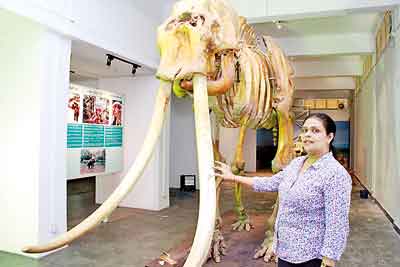
Chamalka Kothalawala with Heiyanthuduwa Raja Pix by Indika Handuwala
Believed to have been born in 1924 in Hambantota, Raja was caught in the wild from Kattakaduwana jungle in Hambantota District on March 8, 1945. The majestic tusker later came to be known as Heiyanthuduwa Raja. When Raja passed away on November 6, 2002 at the age of 78, Raja’s owner, Henry Gunasekera, donated its skeleton to the Colombo Natural History Museum where it has been on display since 2013. From tomorrow, Raja will stand in regal splendour in the new Osteology Gallery.
Replete with the audio effects of the four-legged and feathery friends who would greet a visitor, the new gallery is to educate a visitor on the co-relation between a skeleton of an animal and its habitat. Adding colour to the skeletal friends are the stuffed leopard, crocodile and hippo.
For budding young zoologists and other interested visitors, it will be a journey of learning of our natural heritage.


